A Study on Resource Carrying Capacity and Early Warning of Urban Agglomerations of the Yellow River Basin Based on Sustainable Development Goals, China
Abstract
:1. Introduction
2. Materials and Methods
2.1. Study Area
2.2. Theoretical Frameworks
2.3. Methodology
2.3.1. Comprehensive Resource Carrying Capacity Modeling
2.3.2. Resource Carrying Capacity Indicator System
2.3.3. Resource Carrying Capacity Warnings and Attention Partitions for Dynamic Monitoring Zoning
2.3.4. Resource Carrying Capacity Forecast Warning System
2.4. Data Resource
3. Results
3.1. Resource Carrying Capacities and Indices of Urban Agglomeration in the Yellow River Basin
3.1.1. Land Resource Carrying Capacity
3.1.2. Water Resources Carrying Capacity
3.1.3. Ecological Carrying Capacity
3.1.4. Comprehensive Resource Carrying Capacity
3.2. Early Warning and Grading of Resource Carrying Capacity for Urban Agglomerations in the Yellow River Basin
4. Discussion
5. Conclusions
- (1)
- Based on the sustainable development goal, establishing a “five-dimensional integrated” resource comprehensive carrying capacity evaluation model, this study established a monitoring and early warning system based on sustainable development. It adopted comprehensive and integrated methods, such as the index system method, entropy weight method, geographic information system, and statistical analysis, to construct a theoretical and methodological system, as well as to carry out systematic analysis and research on the alert zoning and early warning grading of the Yellow River Basin’s urban agglomerations. The model’s construction and the framework of this study can aid in monitoring the resource carrying status of the Yellow River Basin and provide scientific support for the ecological protection and high-quality development of the Yellow River Basin, as well as provide a research paradigm for the world’s largest river basin and the sustainable development of man and nature in the world.
- (2)
- The comprehensive carrying capacity of the Yellow River Basin urban agglomerations is in an overloaded state, of which the water resources carrying capacity is in a state of deficit, the population–food–land is in a state of food surplus, and the ecological carrying capacity is in a state of ecological affluence. The integrated resource carrying capacities of the cities in the Yellow River Basin urban agglomeration have obvious spatial differentiation. From west to east, the land and water resources carrying indexes show a downward trend. The water and soil resources pressure in the eastern part of the Yellow River Basin is small. It is necessary to optimize this further to improve the comprehensive carrying capacity of the Yellow River Basin urban agglomeration.
- (3)
- The Yellow River Basin urban agglomerations are in a level-three heavily overloaded state; the negative impacts of resource consumption are more extensive. More cities are in a level-one severely overloaded state, and measures need to be taken to improve the resource carrying capacity. The carrying capacity of water resources is the main factor limiting of the resource carrying capacity of the Yellow River Basin.
- (4)
- The disadvantage of this study is that the carrying capacity index system needs to be further developed, and the accuracy needs to be higher. It is suggested to add environmental, social, economic, information technology, and digital economy indicators; a resource and environmental carrying capacity assessment system based on high score image researched and developed; dynamic monitoring of resource and environmental carrying capacity implemented in the future; and scientific basis for sustainable development goals more accurately provided.
- (5)
- This study provides scientific support and research paradigm for high-quality research in the world’s river basins, including the Yellow River Basin. It is of great significance to the harmonious coexistence between human beings and nature and the construction of ecological civilization.
Author Contributions
Funding
Institutional Review Board Statement
Informed Consent Statement
Data Availability Statement
Conflicts of Interest
References
- Feng, C.; Yang, Y.Z.; Yan, H.M.; Yan, H.M.; Pan, T.; Li, P. A century of research on resource and environmental carrying capacity: From theory to practice. Resour. Sci. 2017, 39, 379–395. [Google Scholar]
- Feng, C.; You, Z.; Yang, Y.Z.; Shi, H. Comprehensive evaluation of Tibet’s resource and environmental carrying capacity based on three-dimensional tetrahedral model. J. Geogr. 2021, 76, 645–662. [Google Scholar]
- Liu, Y.J.; Dai, L.; Zhang, J.; Feng, Z.M.; Pan, T.; Ge, Q.S. Research on Monitoring Resource Carrying Capacity: Taking Three-Rivers Region in Tibet as an Example. J. Nat. Resour. 2020, 35, 1699–1713. [Google Scholar]
- Liu, R.Z.; Wang, Y.B.; He, C. Study on the comprehensive carrying capacity of urban agglomerations in the Yellow River basin from the perspective of high-quality development. Ecol. Econ. 2022, 38, 89–97. [Google Scholar]
- Ye, Y.H.; Han, Z.; Sun, F.F.; Zhang, Y.; Huang, T.; Chen, L.; Li, X. Research on early warning evaluation of small-scale resource and environmental carrying capacity—Taking Dapeng Peninsula as an example. J. Ecol. Environ. 2017, 26, 1275–1283. [Google Scholar]
- Hu, H.; Han, L. Evaluation of Land Carrying Capacity of 31 Provinces in China Based on a Natural–Societal-Supply–Demand Framework. Sustainability 2023, 15, 1037. [Google Scholar] [CrossRef]
- He, M.W.; Yang, X.L. Study on the spatiotemporal dynamics of water resources carrying capacity in the Yellow River Basin from 2010 to 2019. Water Resour. Sci. Cold Reg. Eng. 2022, 5, 59–63. [Google Scholar]
- Wang, J.Y.; Mu, X.Q.; Chen, S.J.; Liu, W.; Wang, Z.; Dong, Z.F. Dynamic evaluation of water resources carrying capacity of the Dianchi Lake Basin in 2005–2015, based on DSPERM framework model and simulated annealing-projection pursuit model. Reg. Sustain. 2021, 2, 189–201. [Google Scholar] [CrossRef]
- Zhang, T.; Hu, Q.N.; Zhou, D.; Gao, W.J.; Fukuda, H. Ecological carrying capacity evaluation for villages’ spatial planning in rural revitalization strategy in gully regions of the Loess Plateau (China). J. Asian Archit. Build. Eng. 2023, 22, 1746–1762. [Google Scholar] [CrossRef]
- Ci, X.; Zhang, L.; Wang, T.; Xiao, Y.; Xia, J. Research on the ECC of Chengdu–Chongqing’s Urban Agglomeration in China Based on System Dynamics. Sustainability 2022, 14, 10896. [Google Scholar] [CrossRef]
- Yu, W.; Tao, T. Scenario Simulation for the Urban Carrying Capacity Based on System Dynamics Model in Shanghai, China. Sustainability 2022, 14, 12910. [Google Scholar] [CrossRef]
- Guo, Q.; Wang, J.Y.; Zhang, B. Comprehensive evaluation of regional water resources carrying capacity based on DPSIRM framework. J. Nat. Resour. 2017, 32, 484–493. [Google Scholar]
- Wang, J.; Sun, T.H.; Li, P.J.; Hou, W. A regional water environment carrying capacity evaluation model based on artificial neural network and its application. J. Ecol. 2007, 26, 139–144. [Google Scholar]
- Tang, Y.Z.; Wang, M.D.; Liu, Q.; Hu, Z.W.; Zhang, J.; Shi, T.Z.; Wu, G.F.; Su, F.Z. Ecological carrying capacity and sustainability assessment for coastal zones: A novel framework based on spatial scene and three-dimensional ecological footprint model. Ecol. Model. 2022, 466, 109881. [Google Scholar]
- Wang, Q.; Li, W. Research progress and outlook of regional resource and environmental carrying capacity evaluation. J. Ecol. Environ. 2020, 29, 1487–1498. [Google Scholar]
- Tang, K.; Tang, C.L.; Zhao, T.T. Evaluation of resource Carrying capacity of Changzhutan based on set pair analysis. Land Resour. Sci. Technol. Manag. 2012, 29, 46–53. [Google Scholar]
- Yang, F.; Chen, Z.M.; Gong, S.B. Evaluation of Land Carrying Capacity of Various Cities in Liaoning Province Based on AHP Entropy Weight TOPSIS Model. Soil Water Conserv. Bull. 2022, 42, 144–149. [Google Scholar]
- Xiong, J.X.; Wang, X.B.; Zhao, D.; Wang, J. Spatiotemporal evolution for early warning of ecological carrying capacity during the urbanization process in the Dongting Lake area, China. Ecol. Inform. 2023, 75, 102071. [Google Scholar] [CrossRef]
- Li, Y.X.; Xue, D.Q.; Song, Y.Y. Early warning of spatial and temporal changes and trends of Water resources of China carrying capacity. Resour. Environ. Yangtze River Basin 2021, 30, 1574–1584. [Google Scholar]
- Li, X.; Guri, A.; Yu, T.; Yin, H.M.; Tu, H.Y. Spatial and temporal dynamic monitoring and driver factor analysis of ecological carrying capacity in 5 Central Asian countries. J. Univ. Chin. Acad. Sci. 2023, 40, 474–485. [Google Scholar]
- Guo, L.S.; Zhu, W.B.; Wei, J.X.; Wang, L.F. Water demand forecasting and countermeasures across the Yellow River basin: Analysis from the perspective of water resources carrying capacity. J. Hydrol. Reg. Stud. 2022, 42, 101148. [Google Scholar]
- Qiao, R.; Li, H.; Han, H. Spatio-Temporal Coupling Coordination Analysis between Urbanization and Water Resource Carrying Capacity of the Provinces in the Yellow River Basin, China. Water 2021, 13, 376. [Google Scholar] [CrossRef]
- Chen, X.H.; Qian, X. Evaluation of the Comprehensive Carrying Capacity of Urban Agglomeration in the Yangtze River Ecological and Economic Zone. Stat. Decis. Mak. 2019, 35, 64–66. [Google Scholar]
- Lu, Y.L.; Xu, S.S.; Si, B.J.; Shen, L. Study on dynamic evolution characteristics of Carrying capacity of water resources in nine provinces (regions) of the Yellow River basin. People’s Yellow River 2021, 43, 103–108. [Google Scholar]
- Tang, J.K.; Ding, W.G.; Li, W.L.; Liu, X.D. Evaluation of Water Resources Carrying Capacity and Research on Obstacle Factors in the Yellow River Basin. People’s Yellow River 2021, 43, 73–77. [Google Scholar]
- Wang, Y.; Lei, S.Z. Study on Evaluation of Carrying capacity of Resources in the Yellow River Basin. People’s Yellow River 2022, 44, 17–21+33. [Google Scholar]
- Li, Y.X.; Cao, M.Y. Study on the spatiotemporal evolution and influencing factors of urban comprehensive carrying capacity in the Yellow River Basin. Ecol. Econ. 2022, 38, 72–81+88. [Google Scholar]
- Zhao, Y.Q.; Dai, R.K.; Yang, Y.; Li, F.; Zhang, Y.; Wang, X.Y. Integrated evaluation of resource and environmental carrying capacity during the transformation of resource-exhausted cities based on Euclidean distance and a Gray-TOPSIS model: A case study of Jiaozuo City, China. Ecol. Indic. 2022, 142, 109282. [Google Scholar] [CrossRef]
- Wang, W.L.; Liu, T.; Luo, G.P. Evaluation of water Carrying capacity in Kyrgyzstan based on Sustainable Development Goals. Arid Zone Res. 2022, 39, 1801–1809. [Google Scholar]
- Cheng, Q.P.; Zhong, F.L.; Zuo, X.A.; Yang, C.L. Evaluation of the Water Resources Carrying Capacity of the Heihe River Basin in the Combination of Beautiful China and the United Nations Sustainable Development Goals. China Desert 2020, 40, 204–214. [Google Scholar]
- Wu, C.; Jiang, A.D.; Zheng, W. Study on the Measures for Optimizing China’s Provincial Territorial Space Based on the Perspective of Resource and Environmental Carrying Capacity in the New Situation. Sustainability 2022, 14, 13754. [Google Scholar] [CrossRef]
- Dong, X.; Gao, S.; Xu, A.; Luo, Z.; Hu, B. Research on Tourism Carrying Capacity and the Coupling Coordination Relationships between Its Influencing Factors: A Case Study of China. Sustainability 2022, 14, 15124. [Google Scholar] [CrossRef]
- Zhang, Z.; Hu, B.Q.; Qiu, H.H. Comprehensive evaluation of resource and environmental carrying capacity based on SDGs perspective and Three-dimensional Balance Model. Ecol. Indic. 2022, 138, 108788. [Google Scholar] [CrossRef]
- Yu, F.W.; Fang, L. Several issues concerning ecological protection and high-quality Development in the Yellow River Basin. China Soft Sci. 2020, 6, 85–95. [Google Scholar]
- Deng, X.Z.; Yang, K.Z.; Dan, J.J.; Dong, S.C.; Zhang, W.G.; Guo, R.X.; Tan, M.H.; Zhao, P.J.; Li, Y.; Miao, C.H.; et al. Urban Agglomeration and Industrial Transformation and Development in the Yellow River Basin. J. Nat. Resour. 2021, 36, 273–289. [Google Scholar] [CrossRef]
- Feng, Z.M. The Past, Present, and Future of Land Carrying Capacity Research. China Land Sci. 1994, 3, 1–9. [Google Scholar]
- Zhao, J.; Wang, Y.; Zhao, C.Z.; Jin, M.Z. Study on Ecological footprint and carrying capacity dynamics of water resources in Yanbian Prefecture. J. China Agric. Univ. 2017, 22, 74–82. [Google Scholar]
- Chen, Z.J.; Tang, D.Y. A Study on the Sustainable Utilization of Urban Water Resources Using the Water Resource Footprint Model: A Case Study of Nanjing City. China Rural Water Resour. Hydropower 2015, 389, 25–28. [Google Scholar]
- Zhao, X.G.; Xiao, L.; Lan, Y.X.; Wang, S.Z.; Ma, C.H. Study on the dynamic of Ecological footprint and ecological carrying capacity in Shaanxi Province. China Agric. Sci. 2005, 4, 746–753. [Google Scholar] [CrossRef]
- Liu, D.; Feng, Z.M.; Yang, Y.Z. Analysis of supply and demand balance of China’s ecological carrying capacity based on Ecological footprint. J. Nat. Resour. 2012, 27, 614–624. [Google Scholar]
- Zhang, D.; Zhu, L.; Ma, X.; Liu, Z.; Cui, H. Uncoordinated Coupling Assessment of New Urbanization and Ecological Carrying Capacity in the Yellow River Basin. Int. J. Environ. Res. Public Health 2022, 19, 9016. [Google Scholar] [CrossRef] [PubMed]
- Chen, Y.; Liu, S.; Ma, W.; Zhou, Q. Assessment of the Carrying Capacity and Suitability of Spatial Resources and the Environment and Diagnosis of Obstacle Factors in the Yellow River Basin. Int. J. Environ. Res. Public Health 2023, 20, 3496. [Google Scholar] [CrossRef] [PubMed]
- Xu, H.J.; Jia, A.; Song, X.L.; Bai, Y.C. Suitability evaluation of carrying capacity and utilization patterns on tidal flats of Bohai Rim in China. J. Environ. Manag. 2022, 319, 115688. [Google Scholar] [CrossRef] [PubMed]
- Fang, C.L.; Bao, C.; Zhang, C.G. Scenario analysis on the Change Situation and Evolution of Ecological Production Life Carrying Capacity in Arid Areas. J. Ecol. 2003, 9, 1915–1923. [Google Scholar]
- Wang, D.H.; Li, X.D. Analysis of Carrying capacity of mountain basin resources and regional coordinated development: Taking Wujiang River basin in Guizhou as an example. Environ. Sci. Technol. 2019, 42, 222–229. [Google Scholar]
- Fauzia, A. Analysis of the carrying capacity of the krueng langsa river basin based on the water management criteria. IOP Conference Series. Earth Environ. Sci. 2023, 1182, 012043. [Google Scholar]
- Zhang, N.N.; Su, X.L.; Zhou, Y.Z.; Niu, J.P. Evaluation of Water Resources Carrying Capacity in the Yellow River Basin. J. Nat. Resour. 2019, 34, 1759–1770. [Google Scholar]
- Zhao, J.F.; Li, Y. Evaluation and spatiotemporal differentiation evolution of the comprehensive carrying capacity of urban agglomerations in the Yellow River Basin. Ecol. Econ. 2022, 38, 75–83. [Google Scholar]
- Wang, Y.J.; Mi, W.B. Study on the Ecological Carrying capacity of the Urban Belt along the Yellow River in Ningxia. Resour. Environ. Arid Areas 2010, 24, 23–27. [Google Scholar]
- Zhou, L.H.; Cao, R.C.; Wang, P.T. Evaluation of Agricultural Production Suitability Based on Land Resource Carrying Capacity: Taking Shaanxi Province as an Example. Ecol. Econ. 2022, 38, 125–130. [Google Scholar]
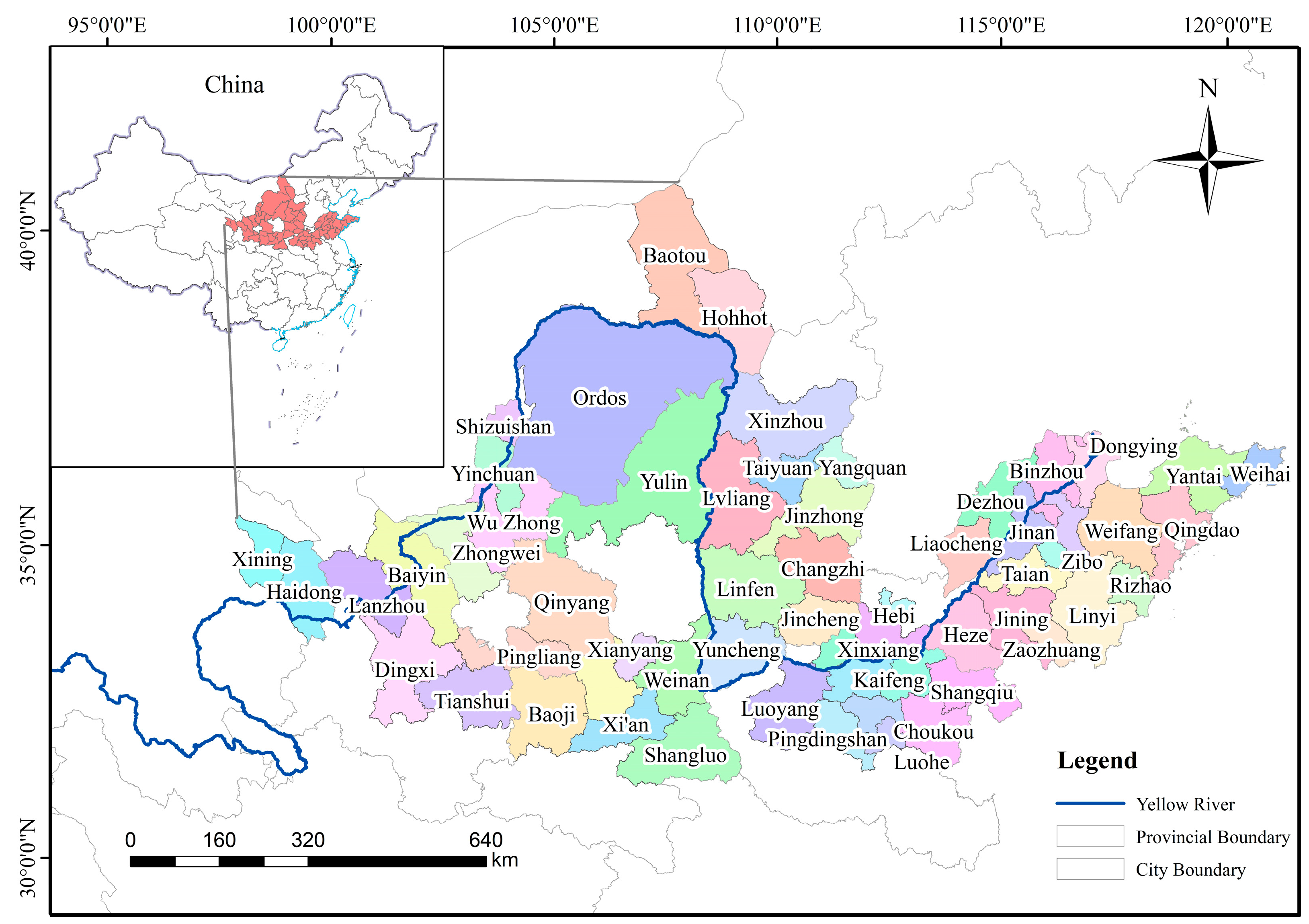
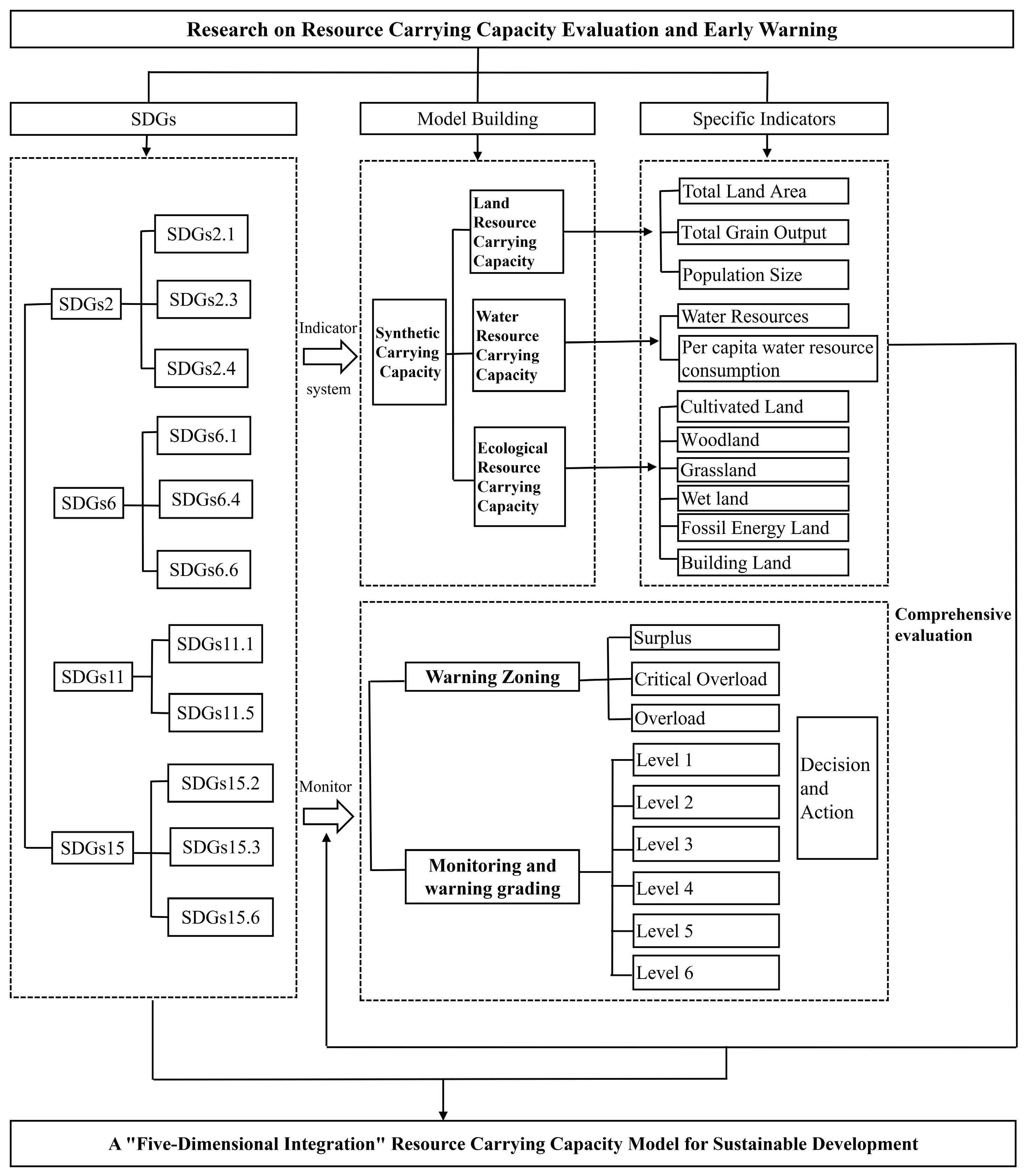
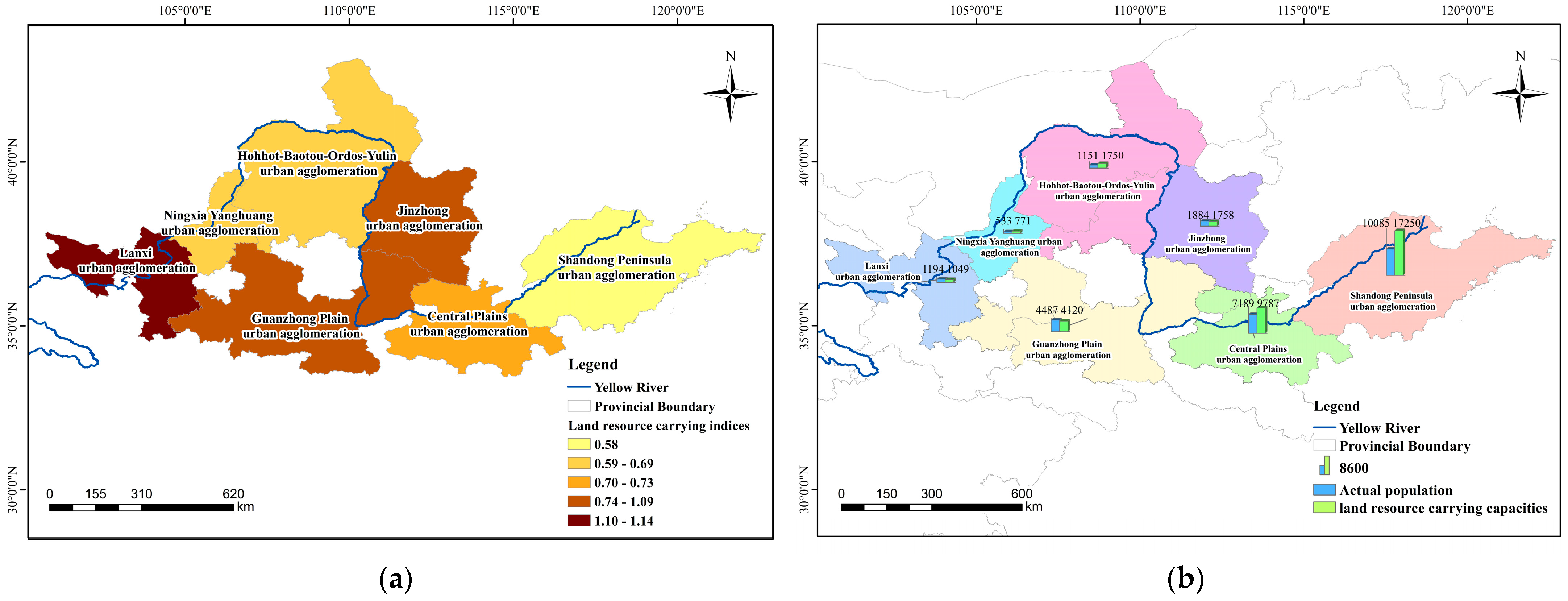
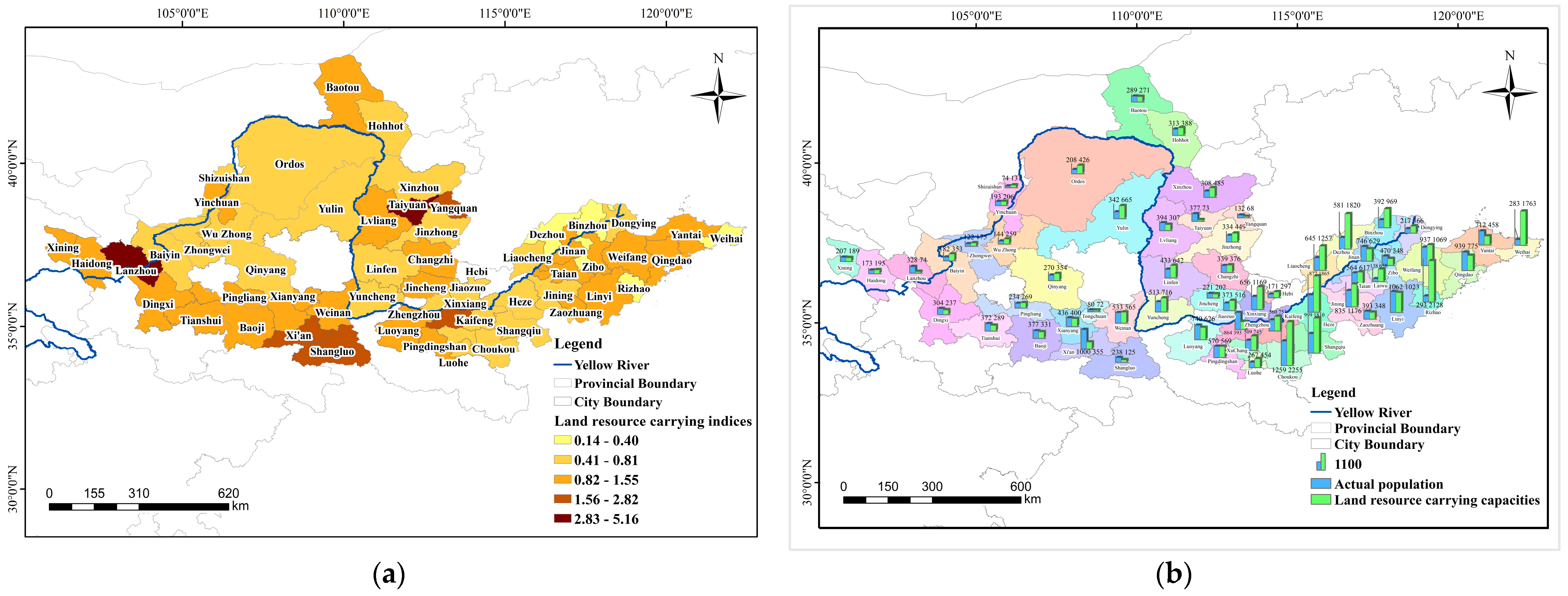


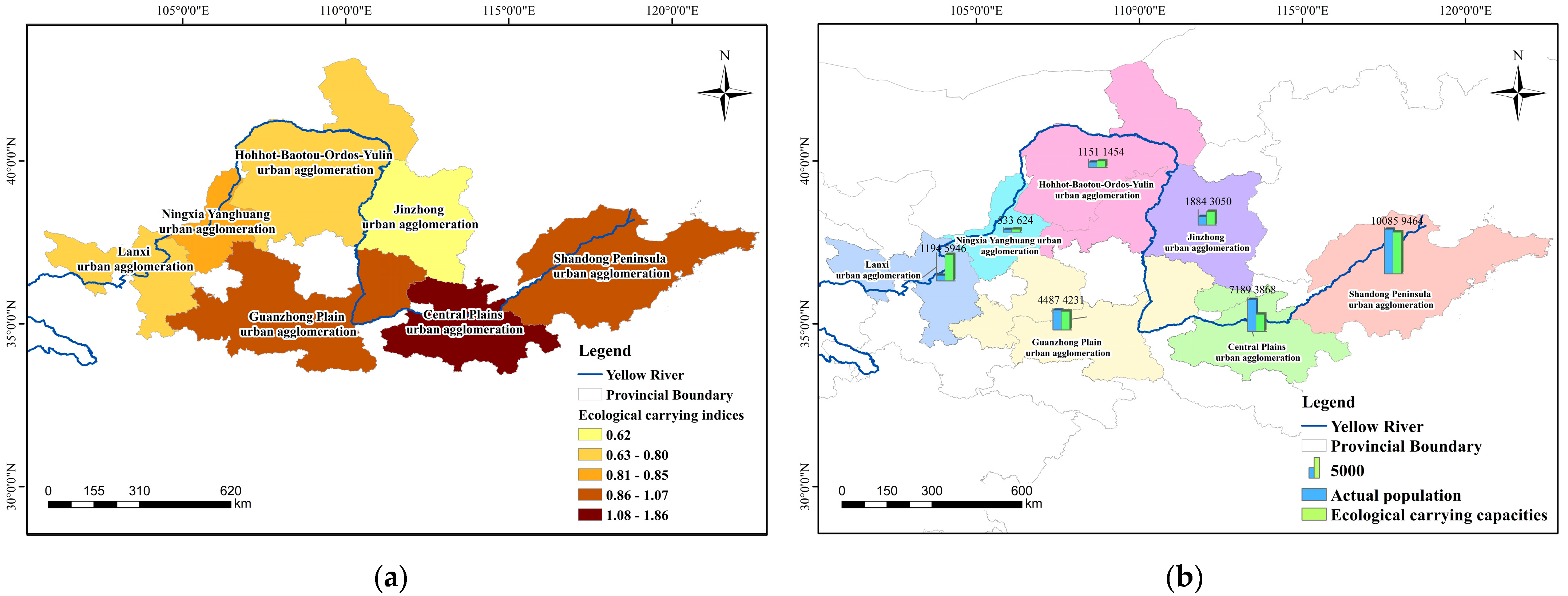
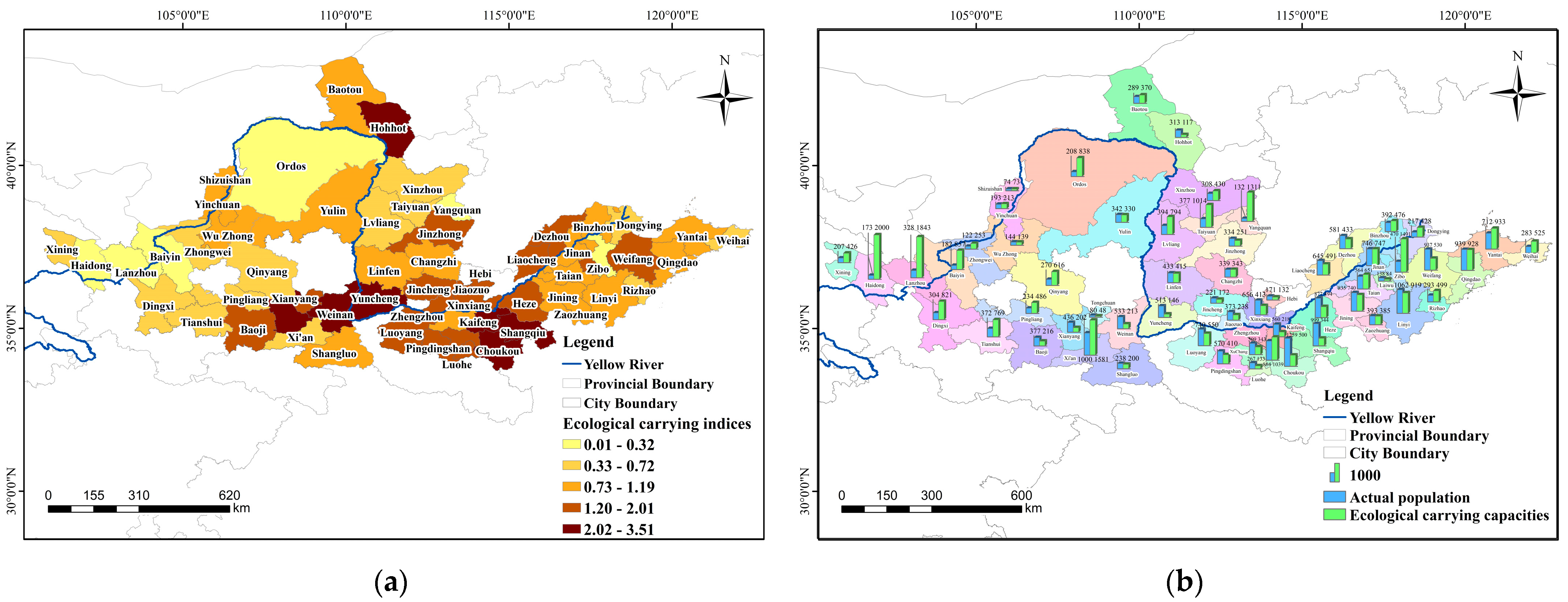

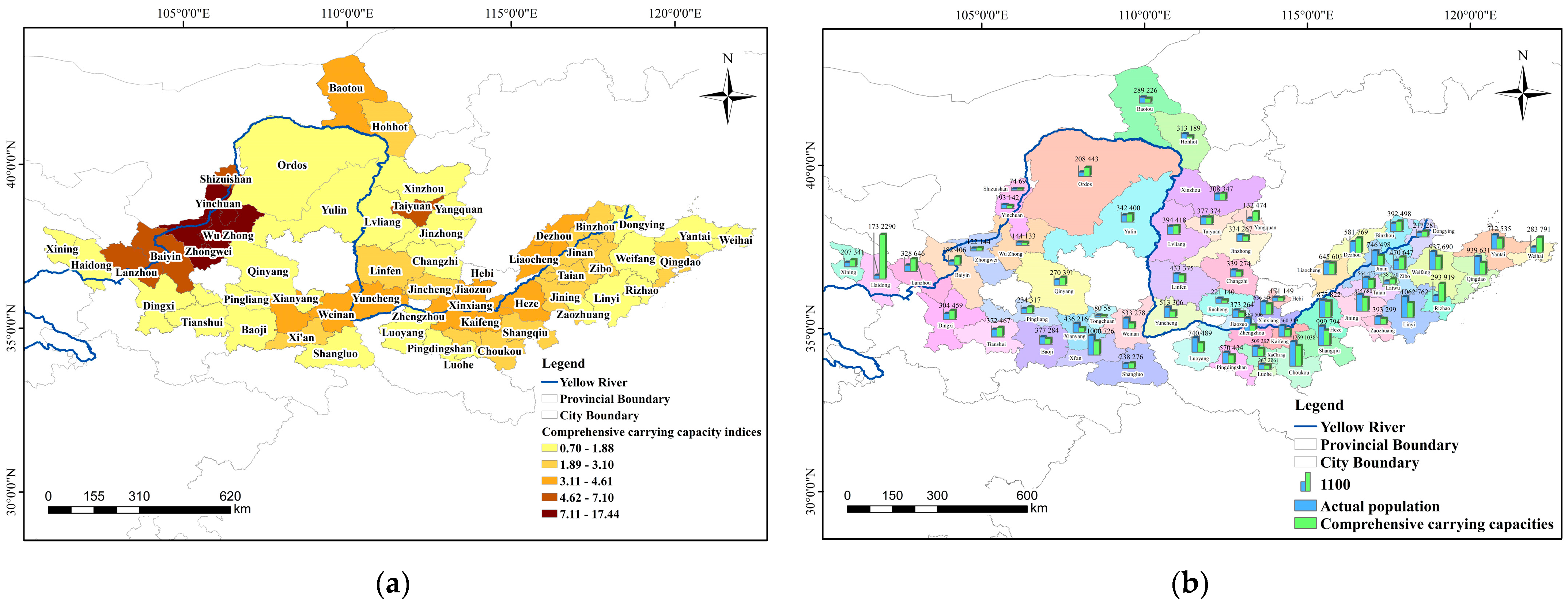
| Type of Resource Carrying Capacity | Calculation Method | Formula | Notes | Reference Sources |
|---|---|---|---|---|
| Land resources carrying capacity | Land resources carrying capacity model | LCC is the land resources carrying capacity (person); G is the total food production (kg); Gp is the per capita food consumption standard (kg/person), and the reference value is 400 kg/person. | Feng, Z.M., et al. [36] | |
| Land resource carrying index model | LCCI is the land resource carrying index; Pa is the actual population of the region (people). | |||
| Water resources carrying capacity | Water resources carrying capacity model | EC is the water resources’ ecological carrying capacity (hm2); 0.4 is the available water after deducting the water resources for maintaining the ecological environment (40%, i.e., 0.4); γ is the water resources balance factor, which is 5.19; ϕ is the water balance factor of the study area; Qw is the total water resources (m3) of the study area; ec is the per capita water footprint (hm2/person); Pw is the global average production capacity of water resources (m3/hm2), which is 3140 m3/hm2; Wp is the per capita water consumption (m3/person); ECC refers to the ecological carrying capacity; and ECCI refers to the ecological carrying capacity index. | Zhao, J., et al. [37] | |
| Water resource footprint model | Chen, Z.J., et al. [38] | |||
| Ecological resource carrying capacity | Ecological resource carrying capacity | EF is the biologically productive area (hm2); EFC is the ecological carrying capacity, i.e., ratio to the ecological footprint per capita; EFCI is the ecological carrying capacity index; j represents arable land, grassland, water, forest land, construction land, and fossil fuel land, respectively; aj is the actual land area for biological production of category j (hm2); rj is the equilibrium factor; yj is the yield factor, i.e., the local per capita yield over the national average yield; ef is the ecological footprint per capita (hm2/person); ai is the area of biologically productive land occupied by i substances per capita (hm2/person); Wi is the equilibrium factor corresponding to the type of land use; Ci is the standard consumption of i substances (kg/person (local per capita production)); Pi is the national average productivity of i substances (kg/hm2), i.e., the national average production per unit area; and n is the number of substances. | Zhao, X.G., et al. [39] | |
EFC = EF/ef | Liu, D., et al. [40] | |||
| Ecological footprint model |
| Overall Target Level | Target Level | Indicator Level | Indicator Measurement Method | SDG Objective |
|---|---|---|---|---|
| Comprehensive resources carrying capacity | Land resources carrying capacity | Land resources carrying capacity | Total regional land area | Sustainable Terrestrial Ecosystems (SDG15.3) |
| Total grain production | Sustainable Agriculture (SDG2.1) | |||
| Per capita food consumption standard | Sustainable Agriculture (SDG2.1) | |||
| Population | Sustainable Cities and Communities (SDG11.5) | |||
| Water resources carrying capacity | Water resources carrying capacity | Total water resources | Clean Water and Sanitation (SDG6.1) | |
| Per capita water consumption | Clean Water and Sanitation (SDG6.4) | |||
| Per capita water footprint | Clean Water and Sanitation (SDG6.4) | |||
| Ecological resources carrying capacity | Arable land carrying capacity | Per capita grain production | Sustainable Agriculture (SDG2.1) | |
| Per capita arable land area | Sustainable Agriculture (SDG2.4) | |||
| Per capita ecological footprint of arable land | Sustainable Agriculture (SDG2.4) | |||
| Grassland carrying capacity | Per capita production of livestock products | Sustainable Agriculture (SDG2.3) | ||
| Per capita grassland | Sustainable Agriculture (SDG2.3) | |||
| Per capita ecological footprint of grassland | Sustainable Agriculture (SDG2.3) | |||
| Forestland carrying capacity | Per capita production of forest products | Sustainable Terrestrial Ecosystems (SDG15.6) | ||
| Per capita forestland area | Sustainable Terrestrial Ecosystems (SDG15.2) | |||
| Per capita ecological footprint of forest | Sustainable Terrestrial Ecosystems (SDG15.2) | |||
| Wetland carrying capacity | Per capita fish production | Sustainable Agriculture (SDG2.3) | ||
| Per capita wetland area | Clean Water and Sanitation (SDG6.6) | |||
| Per capita ecological footprint of wetland | Clean Water and Sanitation (SDG6.6) | |||
| Construction land carrying capacity | Electricity consumption | Sustainable Cities and Communities (SDG11.1) | ||
| Per capita ecological footprint of construction land | Sustainable Cities and Communities (SDG11.1) | |||
| Fossil energy land carrying capacity | Consumption of oil and gas supply | Sustainable Cities and Communities (SDG11.1) | ||
| Natural gas consumption | Sustainable Cities and Communities (SDG11.1) |
| Resource Carrying Capacity | Carrying Status | Specific Status | Status Classification | Carrying Capacity Index | |
|---|---|---|---|---|---|
| Land resources carrying capacity | Food surplus | Richest | Green | LCCI ≤ 0.875 | LCCI ≤ 0.5 |
| Richer | 0.5 < LCCI ≤ 0.75 | ||||
| Rich | 0.75 < LCCI ≤ 0.875 | ||||
| People–food balance | Balance and rich | Red | 0.875 < LCCI ≤ 1.125 | 0.875 < LCCI ≤ 1 | |
| Critical overload | 1 < LCCI ≤ 1.125 | ||||
| Population overload | Overload | Red | LCCI > 1.125 | 1.125 < LCCI ≤ 1.25 | |
| Critical overload | 1.25 < LCCI ≤ 1.5 | ||||
| Seriously overload | LCCI > 1.5 | ||||
| Water resources carrying capacity | Water surplus | Richest | Green | ECI ≤ 0.875 | ECI ≤ 0.5 |
| Richer | 0.5 < ECI ≤ 0.75 | ||||
| Rich | 0.5 < ECI ≤ 0.75 | ||||
| People–water balance | Balanced and rich | Blue | 0.875 < ECI ≤ 1.125 | 0.875 < ECI ≤ 1 | |
| Critical overload | 1 < ECI ≤ 1.125 | ||||
| Water deficit | Overload | Red | ECI > 1.125 | 1.125 < ECI ≤ 1.25 | |
| Critical overload | 1.25 < ECI ≤ 1.5 | ||||
| Seriously overload | ECI > 1.5 | ||||
| Ecological resources carrying capacity | Ecological surplus | Richest | Green | EFI ≤ 0.9 | ECI ≤ 0.5 |
| Richer | 0.5 < EFI ≤ 0.7 | ||||
| Rich | 0.7 < EFI ≤ 0.9 | ||||
| Ecological balance | Balanced and rich | Blue | 0.875 < EFI ≤ 1.125 | 0.875 < EFI ≤ 1.125 | |
| Critical overload | 1 < EFI ≤ 1.1 | ||||
| Ecological deficit | Overload | Red | EFI > 1.1 | 1.1 < EFI ≤ 1.5 | |
| Critical overload | 1.5 < EFI ≤ 2.5 | ||||
| Seriously overload | EFI > 2.5 | ||||
| Discriminatory Conditions for the Resource Carrying Capacity (Counts) | Status Type | Status Level | Grade Classification |
|---|---|---|---|
| “Surplus” state = 3 | No load | Green | Level six |
| “Critically overloaded” state = 1 | Mild load | Blue | Level five |
| “Critically overloaded” state ≥ 2 | General load | Yellow | Level four |
| “Overloaded” state = 1 | Heavy load | Orange | Level three |
| “Overloaded” state = 1 and “critically overloaded” state ≥ 1 | Severe load | Red | Level two |
| ”Overloaded” state ≥ 2 | Extremely severe load | Crimson | Level one |
| Urban Agglomeration | Cities | Land Resources | Water Resources | Ecology Resources | Resource Carrying Status |
|---|---|---|---|---|---|
| Ningxia urban agglomeration | Yinchuan | Blue | Red | Blue | Level 2 |
| Shizuishan | Green | Red | Blue | Level 2 | |
| Wuzhong | Green | Red | Blue | Level 2 | |
| Zhongwei | Green | Red | Green | Level 3 | |
| Hohhot–Baotou–Ordos–Yulin urban agglomeration | Hohhot | Green | Red | Red | Level 1 |
| Baotou | Blue | Red | Green | Level 2 | |
| Ordos | Green | Red | Green | Level 3 | |
| Yulin | Green | Red | Blue | Level 2 | |
| Jinzhong urban agglomeration | Taiyuan | Red | Red | Green | Level 1 |
| Yangquan | Red | Red | Green | Level 1 | |
| Jinzhong | Green | Red | Red | Level 1 | |
| Xinzhou | Green | Red | Green | Level 3 | |
| Changzhi | Blue | Red | Blue | Level 2 | |
| Luliang | Red | Red | Green | Level 1 | |
| Guanzhong Plain urban agglomeration | Xi’an | Red | Red | Green | Level 1 |
| Baoji | Red | Red | Red | Level 1 | |
| Tongchuan | Blue | Red | Red | Level 1 | |
| Weinan | Blue | Red | Red | Level 1 | |
| Xianyang | Blue | Red | Red | Level 1 | |
| Shangluo | Red | Red | Red | Level 1 | |
| Yuncheng | Green | Red | Red | Level 1 | |
| Linfen | Green | Red | Blue | Level 2 | |
| Tianshui | Red | Blue | Green | Level 2 | |
| Pingliang | Green | Red | Green | Level 2 | |
| Qingyang | Green | Red | Green | Level 2 | |
| Shandong Peninsula urban agglomeration | Jinan | Red | Red | Blue | Level 1 |
| Qingdao | Red | Red | Blue | Level 1 | |
| Weihai | Green | Red | Green | Level 3 | |
| Yantai | Red | Red | Green | Level 1 | |
| Dongying | Green | Red | Green | Level 3 | |
| Weifang | Blue | Red | Red | Level 1 | |
| Rizhao | Green | Red | Green | Level 3 | |
| Laiwu | Green | Red | Red | Level 1 | |
| Heze | Green | Red | Red | Level 1 | |
| Zaozhuang | Red | Red | Blue | Level 1 | |
| Dezhou | Green | Red | Red | Level 1 | |
| Binzhou | Green | Red | Green | Level 3 | |
| Linyi | Blue | Red | Red | Level 1 | |
| Jining | Green | Red | Red | Level 1 | |
| Liaocheng | Green | Red | Red | Level 1 | |
| Tai’an | Blue | Red | Green | Level 2 | |
| Zibo | Red | Red | Green | Level 1 | |
| Lanxi urban agglomeration | Lanzhou | Red | Red | Green | Level 1 |
| Dingxi | Red | Blue | Green | Level 2 | |
| Baiyin | Green | Red | Green | Level 3 | |
| Xining | Blue | Green | Green | Level 5 | |
| Haidong | Blue | Red | Green | Level 2 | |
| Yellow River Basin | City Cluster | Green | Red | Green | Level 3 |
Disclaimer/Publisher’s Note: The statements, opinions and data contained in all publications are solely those of the individual author(s) and contributor(s) and not of MDPI and/or the editor(s). MDPI and/or the editor(s) disclaim responsibility for any injury to people or property resulting from any ideas, methods, instructions or products referred to in the content. |
© 2023 by the authors. Licensee MDPI, Basel, Switzerland. This article is an open access article distributed under the terms and conditions of the Creative Commons Attribution (CC BY) license (https://creativecommons.org/licenses/by/4.0/).
Share and Cite
Bu, X.; Wang, X.; Wang, J.; Shi, G. A Study on Resource Carrying Capacity and Early Warning of Urban Agglomerations of the Yellow River Basin Based on Sustainable Development Goals, China. Sustainability 2023, 15, 14577. https://doi.org/10.3390/su151914577
Bu X, Wang X, Wang J, Shi G. A Study on Resource Carrying Capacity and Early Warning of Urban Agglomerations of the Yellow River Basin Based on Sustainable Development Goals, China. Sustainability. 2023; 15(19):14577. https://doi.org/10.3390/su151914577
Chicago/Turabian StyleBu, Xiaoyan, Xiaomin Wang, Jiarui Wang, and Ge Shi. 2023. "A Study on Resource Carrying Capacity and Early Warning of Urban Agglomerations of the Yellow River Basin Based on Sustainable Development Goals, China" Sustainability 15, no. 19: 14577. https://doi.org/10.3390/su151914577
APA StyleBu, X., Wang, X., Wang, J., & Shi, G. (2023). A Study on Resource Carrying Capacity and Early Warning of Urban Agglomerations of the Yellow River Basin Based on Sustainable Development Goals, China. Sustainability, 15(19), 14577. https://doi.org/10.3390/su151914577






